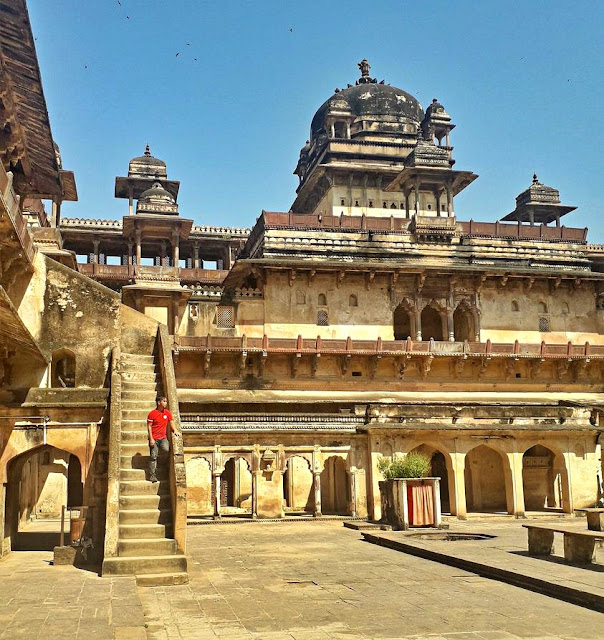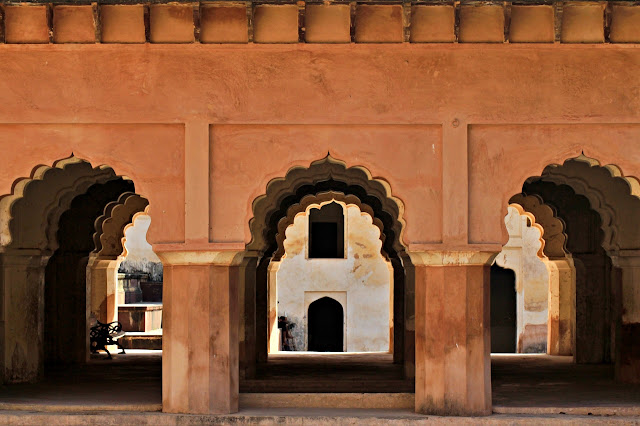Built between 1605 and 1626 upon the command of Vir Singh Deo to commemorate Mughal Emperor Jahangir's first visit to Orchha (father of Shah Jahan- architect of Taj Mahal), Jahangir Mahal is considered as one of the best representations of classic Indo-Islamic Architecture. Marvelous sculptures, hanging balconies, delicate trellis and chhatris, topped domes, etc., are all examples of the building's exceptional architectural brilliance.
 |
| The many domes of the palace arrest your attention |
Jahangir Mahal is a three-story palace situated on the banks of Betwa River that combines Hindu and Islamic design elements. This stunning structure has more than a hundred rooms, verandas, terraces, porches, as well as multiple enormous courtyards and ornate ceilings. The original eastern entrance to the palace includes walls tiled in turquoise, and the gate itself is elaborately carved.
 |
| Like other palaces and forts in India, one never ran out of places to explore |
Fascinating details include the separate rooms for each of Vir Singh Deo’s six wives and a window in the Maharaja’s bedroom window that looks directly onto the deity altar of nearby Raja Ram Temple.
 |
| The huge water tank |
However, its history would take a bizarre twist when Aurangzeb — the son of Shah Jahan and Jahangir’s grandson — would later conquer Orchha as a young 16-year-old and hoist a Mughal flag at the topmost part of the palace originally built in honor of his grandfather as a token of friendship.
 |
| Inside, you will find many paintings and carvings on the walls |
During the height of the Mughal empire, I suppose, there were no more permanent allies much like there aren’t in modern politics.
Post-Madhya Pradesh Tourism Summit Familiarization Trip
After covering the Travel Mart in Bhopal, I selected this leg of the post-event media familiarization trip for a chance to explore more of the state of Madhya Pradesh. Orchha, along with Gwalior and Chanderi were the places we explored for almost a week.
 |
| Getting lost atop the palace |
I also found it incredible to connect Orchha with other Mughal Empire monuments that I originally learned about during my first trip to India in 2014.
A symbol of Orchha’s Struggle
This palace serves as a living reminder of Orchha's struggle to repel invading forces. It witnessed how Raja Vir Singh Deo and his forces protect it from the Mughal invasion. Fighting to the end, Singh Deo finally surrendered and agreed to be governed by the Mughal empire led by Aurangzeb.
 |
| The palace is surrounded by fortresses and a forest |
Following the defeat to the Mughal army, the military might of Orchha weakened forcing Vir Singh Deo to go into hiding until his death.
The more I satisfy my curiosities examining the palace, from finding myself walking at the uppermost dome to the courtyard below behind the enormous square-shaped water tank to weaving my way to various hallways and rooms, the more impressions of the place's history get imprinted on me.
Jahangir Mahal, along with the other historic buildings in Orchha including the Raja Ram Temple, Laxmi Temple, Sheesh Mahal, and Sri Charturbhuj Temple, reveals the opulence and wide reach of the Mughal Empire as well as the complex political intrigue that went on behind the scenes.























